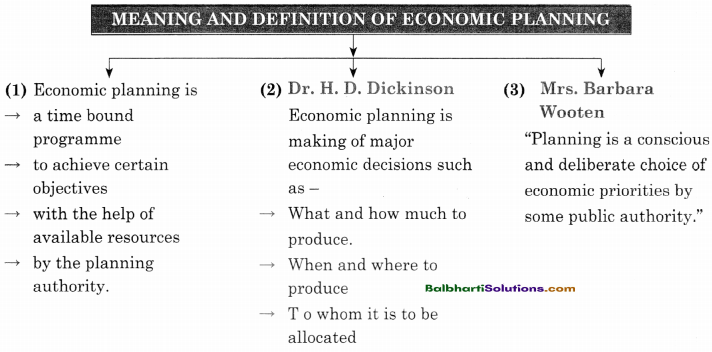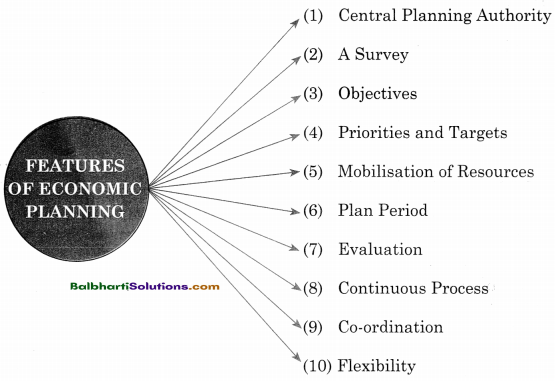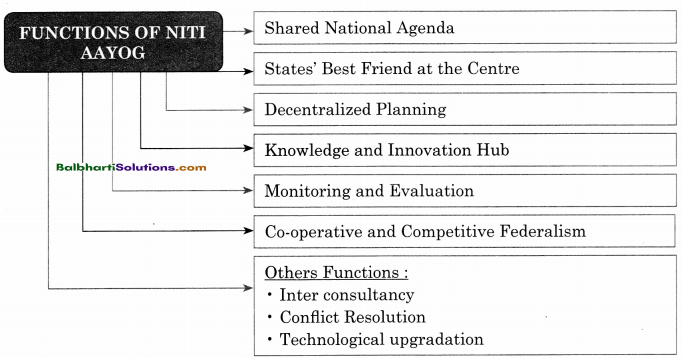By going through these Maharashtra State Board Class 11 Economics Notes Chapter 10 Economic Planning in India students can recall all the concepts quickly.
Maharashtra State Board Class 11 Economics Notes Chapter 10 Economic Planning in India
→ Economic Planning in India:
- Responsible for formulation of economic plans
- Established by Government of India in 1950
- Consists of experts in banking, finance, etc.
- The Prime Minister acts as Ex-officio Chairman of the Planning Commission

![]()
→ Meaning And Definition Of Economic Planning:
(1) Economic planning is –
- a time bound programme
- to achieve certain objectives
- with the help of available resources
- by the planning authority.
(2) Dr. H. D. Dickinson
Economic planning is making of major economic decisions such as –
- What and how much to produce.
- When and where to produce
- To whom it is to be allocated
(3) Mrs. Barbara Wooten
“Planning is a conscious and deliberate choice of economic priorities by some public authority

→ Features of Economic Planning:
- Central Planning Authority
- A Survey
- Objectives
- Priorities and Targets
- Mobilisation of Resources
- Plan Period
- Evaluation
- Continuous Process
- Co-ordination
- Flexibility

→ 12th Five Year Plan (2012 – 2017):
↓
Sustainable Growth
↓
Targets Of 12th Five Year Plan:
1. Economic Growth:
- To achieve real GDP growth rate at 8%.
- To achieve agriculture growth rate at 4%.
- To achieve manufacturing or industrial growth rate at 10%.
- To achieve higher average growth rate for every State.
2. Poverty And Employment:
- To reduce head-count ratio of poverty.
- To create new work opportunities in the non-farm sector.
3. Education:
- To increase mean years of schooling to 7 years.
- To provide access to higher education.
- To eliminate gender and social gap in school.
4. Health:
- To reduce total fertility rate.
- To reduce malnutrition among children.
5. Infrastructure:
- To increase investment in infrastructure.
- To connect villages with all weather roads.
- To increase rural television and telephone density.
![]()
6. Environment and Sustainability:
To increase green cover by 1 million hectare.
7. Service Delivery:
- To provide access to banking services to households.
- To shift subsidies to direct cash transfer through Aadhar card.
→ Niti Aayog (National Institution For Transforming India):
- Formation of NITI Aayog was an innovative and remarkable step to reinforce the principles of federalism and decentralisation of power.
- Accelerate economic growth and development.
- Think – Tank Functions :
- aims to evolve a sha vision of national development with the active involvement of state.
- Co-operative federalism

→ Pillars of Niti Aayog:
- Vision Document of India
- Appraisal Document
- Transforming India: Lecture series
- Doubling of Farmers’ Income
- Global Entrepreneurship Summit 2017
- Outcome Budget and Output-Outcome Framework.
- Launching of Programme.

→ Structure Of Niti Aayog:
1. Governing Council
- Chief ministers of all States
- Governors of Union Territories
2. Regional Councils:
to address specific issues and contingencies impact on more than one state
3. Special Invitees
Experts, specialists, practitioners nominated by Prime Minister.
4. Organizational Framework
- Chairperson : Prime Minister of India
- Vice Chairperson: appointed by the Prime Minister.
Full time members – 5
Part time members – 2 - Ex-officio Members Maximum of 4 members from Council of Ministers, nominated by the Prime Minister.
- Chief Executive Officer (CEO) appointed by the Prime Minister for fixed period in the rank of Secretary to the Government of India.
- Secretariat (if necessary)

![]()
→ Functions Of Niti Aayog:
- Shared National Agenda
- States’ Best Friend at the Centre
- Decentralized Planning
- Knowledge and Innovation Hub
- Monitoring and Evaluation
- Co-operative and Competitive Federalism
Others Functions :
- Inter consultancy
- Conflict Resolution
- Technological upgradation

Word Meaning:
designated – to appoint; comprehension – overall/including all; conscious – aware; deliberate – purpose; priorities – great importance; accelerating – to speed up; attainment – to achieve; varies – to differ; appraisal – to judge something; incorporate – include; implementation – to carry out; sustainable – to be maintained; opportunities – openings; eliminate – to remove; malnutrition – lack of proper food for necessary growth and health; beneficiaries – a person who gets benefits; reinforce – to promote; federation – government system; decentralisation – transfer of authority; sanctioned – to approve; premier – top most; contingencies – emergency; championing – to promote; consultancy – professional practitioner giving expert advice; state of the art – modern; replication – to copy something; rigorous – strict; metrics – a standard; bottlenecks – blockage.